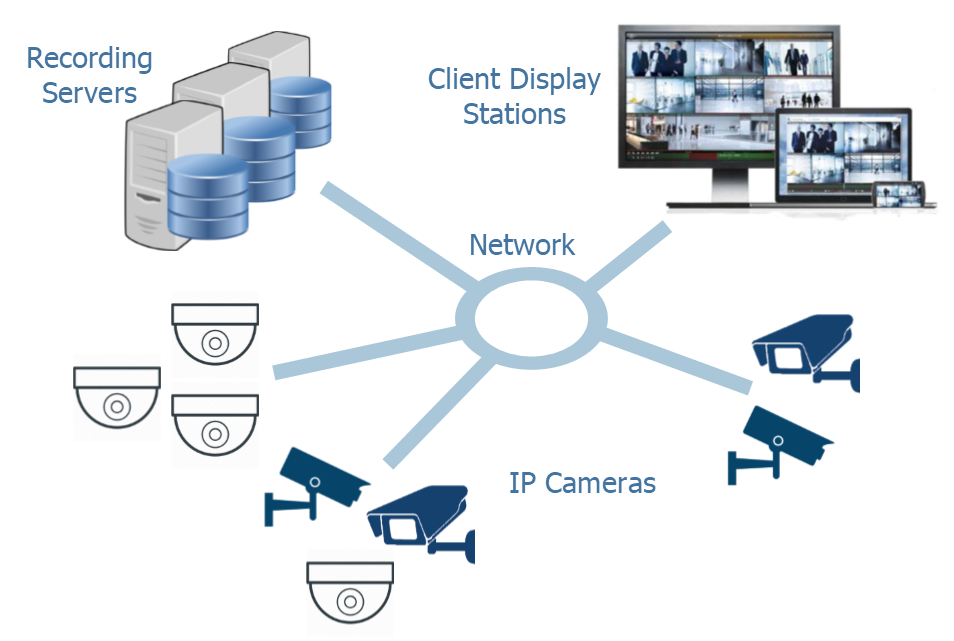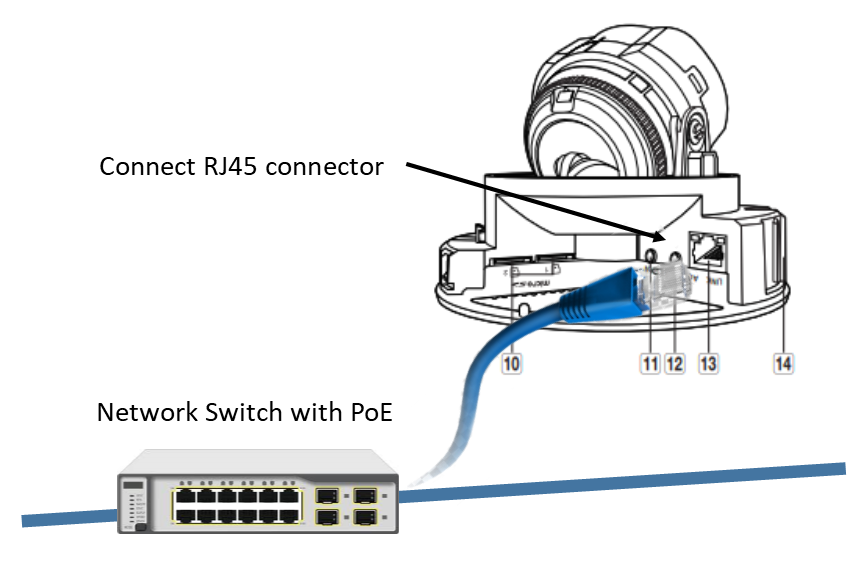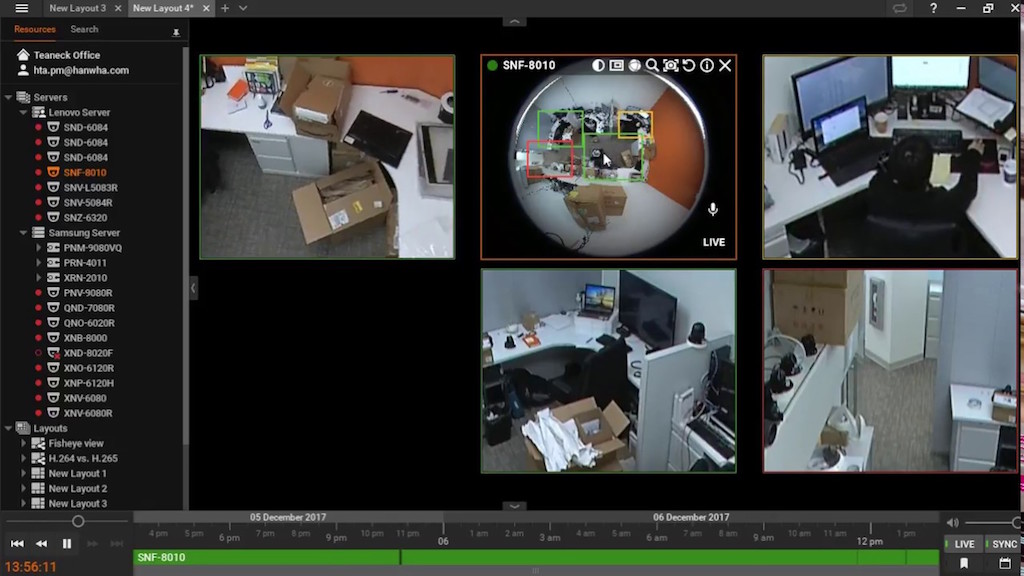What is an IP Camera System?
The “IP” means that the camera connects to the network rather than to a DVR using a coax cable.
The IP camera system includes not only the cameras but also the video recording system. The cameras and the recording system connect to a network switch. The IP camera systems may also integrate with IP door access control and IP Intercoms.
This article describes how to install your IP camera system. It reviews all the steps required to mount the cameras, install it on the network, and connect it to your video recording system.

How to Install the IP Camera
One of the first things to do is the site survey. This makes sure you get the best coverage for your IP camera system. You only need one blind spot to miss the critical video of someone taking your merchandise, a person falling, someone stealing a car or the wrong person in the computer room. Therefore, selecting the right IP cameras and their location is an essential part of providing a secure and safe environment.
Install Your Network Infrastructure
The IP camera requires a PoE (Power over Ethernet) network connection. Installation requires running the network cables, adding switches, and adjusting the cameras to view the areas you want to see.
Run the network cable through the walls and ceilings to all the locations where you would like to install the IP cameras.
Plan Ahead
Surveillance camera requirements tend to increase after you install the initial batch of cameras. You may find it necessary to add cameras in other locations. For example, if you install IP cameras in the halls, you may later realize that you need more cameras in the stairwell, offices, or classrooms. Try to anticipate your needs to minimize labor.
Add Network Switches with PoE
Network-attached cameras use Power over Ethernet (PoE). It is essential to add network switches that include PoE (or use a PoE injector). Make sure that the network switch has enough power to support IP devices on all the ports. Some switches have a power budget that limits the power to all the ports, so look carefully at the specifications. You can also attach many door access control readers and paging amplifiers to the network switch that includes PoE.
Install the IP Camera Mounting Brackets
Some IP cameras make it easy to install cameras. Take a look at the new X-Series IP cameras from Hanwha. These cameras allow you to install the camera brackets and then come back later to mount the rest of the camera.
Mount the IP Cameras

Connect the IP camera to the network cable with PoE. Mount the camera onto the bracket. Roughly adjust the position of the camera to view the area that you want to surveil.
Setup the IP Camera on the Network
You can then view the camera video using a laptop. You can use a web browser to see the video and make changes to any of the camera settings. Each camera manufacturer provides a method of getting to the IP camera for the first time. Some IP camera manufacturers utilize the automatic services supplied by DHCP. For example, the Hanwha cameras IP address will be assigned from the DHCP server automatically. If there is no DHCP server available, the IP address will be set to a default address that is specific to each manufacturer. For example, Hanwha uses the default IP address of 192.168.1.100.
Many camera manufacturers provide software tools to help you install the cameras. For example, Hanwha has an installation tool that can be used to find all their cameras on the network. Once the camera is found, you can enter the initial password, “4321” to configure the IP Address, Subnet Mask, Gateway, HTTP Port, VNP Port, IP type. After changing the camera settings, make sure you change the password.
Make Final Adjustments
Once you can see the video either using a web browser or Video Management System, you can make the final adjustments to the field of view and focus of the IP cameras. Some cameras allow you to make position and zoom adjustments from the computer. If you don’t have a camera with remote set up, you will have to manually set the direction, the field of view and focus manually.
For example, the QND-7084R has a remote zoom lens. If the camera is aimed in the right direction, you can remotely adjust the field of view from your web browser. Other cameras, such as the Axis Q3615 and the Hanwha XNV-6081Z are dome cameras with remote Pan, tilt, rotate, and zoom (PTRZ) capability. PTRZ allows you to point the camera from your computer, adjust the field of view, zoom, and focus.
Setup the IP Cameras
The latest IP camera systems provide a lot of intelligence. The built-in analytics allow you to be notified if a person (or object) crosses a line, if a person leaves a package, or takes your laptop (or any object). All these special functions can be adjusted from the IP cameras built-in web page.
Install the Video Management and Recording System

After you have installed the IP cameras on your network, you can register them in your video management and recording system.
There is a choice of video management systems available. There is software (VMS) that runs in your Windows computer or Network Video Recorders. In both cases, the video management system records the video from the IP cameras and allows you to set up and manage your IP cameras. They also provide rules for notification of alarms such as motion detected or camera failures.
Video Management Software
The VMS (Video Management Software) is more flexible and can support more IP cameras. One example is WAVE from Hanwha. This is an easy to use software product that provides a lot of flexibility and can be integrated with Door Access Control Systems. Another software example is Ocularis from Qognify. The Ocularis VMS can support a very large number of IP cameras across many servers and locations. It is flexible but more complicated to install and operate than the WAVE VMS.
To install the VMS, download the software from the appropriate website. Follow the steps provided. For example, WAVE includes an Installer Wizard that will help you through the process.
Network Video Recorders
The NVR or network video recorders are easier to install and use than the software solution. They are not as flexible but are an excellent solution when all you need to do is record the video.
Whether you use VMS or NVR to manage your IP cameras, you will need to enter the license code before using the system.
IP Camera System Installation Summary
IP camera systems include IP cameras and the video management and recording system. All the cameras attach to your network and use PoE for their power. These IP camera systems are much easier to install than the older CCTV camera systems. They also provide much more functionality.